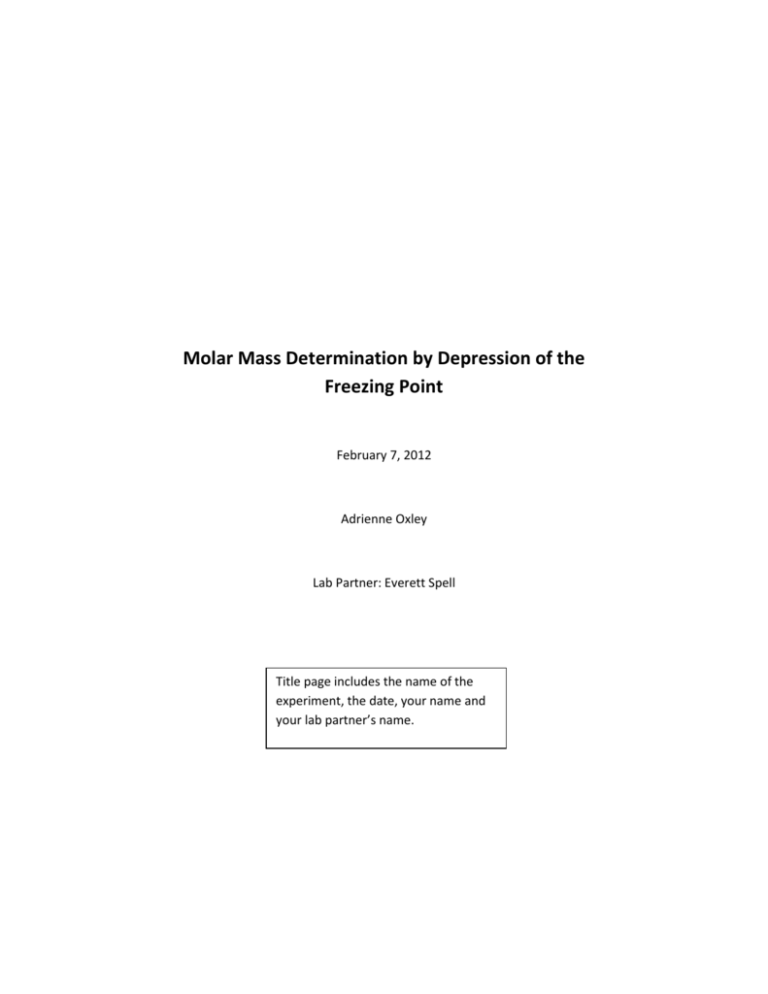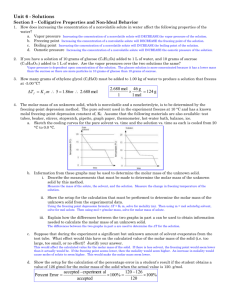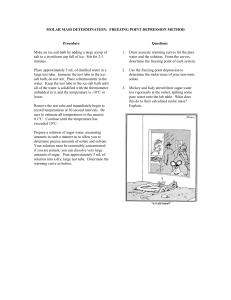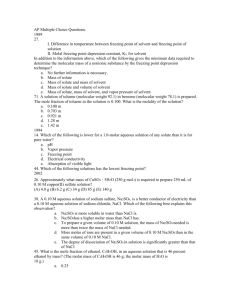Molar Mass Determination by Depression of the
advertisement

Molar Mass Determination by Depression of the Freezing Point February 7, 2012 Adrienne Oxley Lab Partner: Everett Spell Title page includes the name of the experiment, the date, your name and your lab partner’s name. Introduction: This experiment focused on colligative properties, properties that are based on the concentration of solute particles present and not In text references are shown as superscripts which correspond to a numbered reference found at the end of the report (in the reference section) the chemical identity of the solute. Freezing point depression was used to study the molar mass of a substance.1 This colligative property is based on the idea that a solution freezes at a lower temperature than the pure solvent.1,2 By adding unknown impurities to a solution of water and studying the effects this solute “impurity” has on the freezing point, valuable information about the identity of the substance can be obtained. The following equation describes the idea of freezing point depression: ΔTf = iKfm The ΔTf term indicates the change in temperature observed for the Introduction includes explanation of concepts found in key equations. All variables used are clearly defined (see highlighted portion) solution relative to that of the pure substance (the freezing point depression), kf is a term specific to the identity of the solvent being used (in this case water is used and kf is 1.86 ⁰C/m), and m is the molality of particles in the solution (a measure of moles of solute per kg of solvent). By measuring a change in temperature, the molality of an aqueous solution can be calculated and this information can Use figures whenever possible to illustrate points (Note: if you use a figure, you need to reference it and refer to it in the text – there should be explanation of the figure). subsequently be used to determine molar mass (provide the initial mass of sample was recorded). Figure 1 shows a typical phase diagram for a pure solvent (the smaller line inside) and the effects on the phase diagram when a solute is added to make a solution (outer line). The equilibrium lines present in this phase diagram are shifted in the presence of a 3 Figure 1. Phase diagram illustrating fp depression solute and the new diagram indicates a lower freezing point for the solution. Solvent is the only thing that freezes, not the solute “impurity” and so the solute molecules are left behind.2 The freezing/melting point of a solution is the phase change between solid and liquid substances (equilibrium state). Molecules must leave and enter the solid phase at the same rate, which occurs at a lower temperature for the solution based on the lowering of the vapor pressure. This phenomenon is the basis for “salting” roads in the winter. The salt, solute particles, lower the freezing point of water (in the form of snow/rain) so that it takes lower temperatures for roads to freeze over. Purpose: This experiment has three separate, yet related purposes: (1) to determine the freezing point of water, (2) to find the freezing point of a solution (both liquid and solid unknown), and (3) to use this information to determine the molar mass of an unknown substance. Usually in undergraduate laboratory sessions, experimental procedures are taken directly from or adapted from laboratory texts. This information needs to be referenced. Purpose is clearly stated and to the point. Purpose makes connections between steps of the experiment (sometimes the purpose will include info as to the methods being used to obtain the desired information) Procedures:1 First the freezing point of water was determined by preparing a water-ice mixture and recording, with a thermometer, the lowest temperature observed. This measurement was performed in an insulated cup to minimize heat loss to the surroundings and prevents uncalibrated thermometers from interfering with results. Second, the freezing point of a solution of water and an unknown liquid was obtained. A water-ice mixture was prepared as in the first part of the experiment and a calculated amount of liquid unknown was added to this solution by weighing the sample on the balance. The amount added, 10 g, was determined by assuming the In the formal laboratory report, procedures should be in past tense. Also, avoid the use of “you”, “I”, “we”, etc. molality of the resulting solution to be approximately 2 m and the molar mass to be 50 g. The liquid solution was stirred until a temperature decrease of at least 4 degrees was observed (in the event that a 4 degree decrease was not observed, more solute was added). The solution was thoroughly stirred and the lowest temperature recorded. The solution was strained to remove ice and then weighed. This data was then used to determine the freezing point depression and molar mass (see Data and Calculations section). These procedures were repeated for a second trial. The procedures used in determining the freezing point of a solution of unknown liquid were repeated using an unknown solid. The appropriate amount of solid solute was weighed on a balance and added to a small amount (approximately 20 mL) of water. The solid solution was then added to the water-ice mixture, which was stirred thoroughly and the lowest temperature recorded. Freezing point depression was calculated and used to determine molality, which was subsequently used to determine molar mass (again, see Data and Calculations section). Again, these procedures were repeated for a second trial. In the event that the calculated molar mass was less than the actual molar mass for the solid unknown, the substance was identified as ionic and the van’t Hoff factor was determined. The i value is a ratio of true molar mass to calculated molar mass. Data and Calculations: The following data tables summarize the experimental data. Temperature values were observed, other data was determined through calculations. Sample calculations are shown below. Table 1. Freezing Point Data and Molality Calculations Data is tabulated and organized. All values have units associated with them and calculated values are reported to the appropriate number of significant figures. Substance Freezing Freezing Point Calculated Mass of Mass of Mass of Point (⁰C) Depression * Molality** unknown solution Solvent (⁰C) (mol/kg) Solute (g) (g) (g) Pure water 0.2 --- --- --- --- w/Liquid -3.8 4.0 2.2 10.21 120.29 110.08 -3.9 4.1 2.2 9.69 156.17 146.48 -4.6 4.8 2.6 10.07 105.11 95.04 -4.3 4.5 2.4 11.21 132.35 121.14 (Trial 1) w/Liquid (Trial 2) w/Solid (Trial 1) w/Solid (Trial 2) Table 2. Calculated and Actual Molar Mass Values*** (g/mol) (Note: values in parentheses indicate numbers to appropriate significant figures) Tables are clearly labeled and described. Unknown Trial 1 Trial 2 Average Actual Percent Error**** Liquid 43.13 30.07 (Methanol) (43) (30) Solid (NaCl) 41.07 38.24 (41) (38) 36.60 (37) 32 14.38 % (14%) 39.66 (40) 58.5 32.21% (32%) Finding Change in Temperature: *∆Tliquid = Tfinal – Tinitial = -3.8°C – 0.2°C = -4.0 °C (Note: the negative sign indicates that the temperature decreased but does not need to be carried through the calculations) Using ∆T to find molality (note: assuming i = 1): **∆Tf = Kfm Clearly labeled example calculations are shown for each type of calculation performed (including units). m = ∆T/Kf = 4.0 °C/1.86 °C/m = 2.15 m = 2.15 mol/kg = 2.2 mol/kg ***Using mass of solvent and unknown in conjunction with molality to find molar mass: Mass of solution: 121.19 g Mass of liquid unknown added: 10.21 g Mass of solvent (water): 121.19 g – 10.21 g = 110.98 g = Molar Mass(MM) x molality = MM x 2.2 mol/kg MM = 43 g/mol molar mass of liquid unknown ****Percent Error Reported for Molar Masses: = x 100 = 14.38 % = 14 % Van’t Hoff factor Calculations (for solid): i = Actual molar mass/average molar mass = 58.5/39.66 = 1.4 Discussion: The freezing point depression is a colligative property of solution, meaning it depends only on the amount of substance and not on the chemical properties of the substance. In order to ensure accuracy, a freezing point depression of at least 4.0 °C was to be observed. Any values less than this would have indicated insufficient solute particles to impact the freezing point by an amount that would have allowed for accurate calculation of molar mass. The freezing point of pure water was determined in part A of the experiment. Freezing point values obtained in parts B and C were compared to this value to determine the depression. The unknown liquid resulted in a freezing point depression of 4 °C and the solid unknown yielded a depression of 4.8 °C. Both values fell within the required depression of 4.0 °C and so no additional solute needed to be added to the water/ice mixture. Discussion presents the data obtained and compares this data to various trials and to expected data. These values were used to determine the molality of solution for a liquid unknown and a solid unknown. In the case of the liquid unknown (later identified as methanol), the calculations shown above indicated an average molality of 2.2 mol of methanol per kg of water (2.15 for trial 1 and 2.20 for trial 2). This value was compared to the original mass of unknown added to the water/ice mixture. The liquid unknown, methanol, should have had a molar mass of 32 g/mol, however the observed molar mass was an average of 37g/mol (43.13 g/mol for trial 1 and 30.07 g/mol for trial 2). When taking only the average into consideration, the percent error was calculated to be approximately 14%. While the values appeared to be relatively close to one another, the error is significant (typically an error of less than 5% is desired). This error may have been the result of a number of experimental errors. While recording temperature of the water/ice mixture upon addition of unknown liquid, the sample was not Possible sources of experimental error are outlined in the discussion. An explanation of error is given rather than a blanket statement of “human error”. There is also mention as to how the source of error would influence the data. vigorously stirred and so the value may have been invalid. Constant stirring of solution would have assured even mixing of solute particles and a more accurate determination of freezing point. Also, upon measuring the mass of decanted solution for trial 1, some of the liquid spilled onto the bench top. This would have resulted in a lower mass and thus the higher observed molar mass value. Variations in calculated values between trials were most likely the result of inconsistent measurements – more solutions was present in trail 2 and a different mass of solute was introduced. The same procedures were followed for solid unknown (later identified as NaCl). The calculations indicated an average molality of 2.5 mol of NaCl per kg of water (2.58 for trial 1 and 2.42 for trial 2). The molar mass was again determined by comparing this value to the original mass of unknown added to the water/ice mixture. The molar Percent errors are calculated and discussed. This allows the experimenter to comment on the accuracy of the data. mass of NaCl should have been 58.5 g/mol, however an average value of 40 g/mol was calculated (41.07g/mol for trial 1 and 38.24 g/mol for trial 2). This gave a percent error of approximately 32%. The solid produced an even greater error than the liquid unknown. This may be due to the fact that the solid unknown was actually an ionic compound and so the van’t Hoff factor was necessary to account for the presence of multiple ions per unit of NaCl. This may also be due to a lack of stirring the water/ice mixture upon addition of the unknown, as was the case in the liquid unknown. Another source of error may have been the solid unknown not completely dissolving in water prior to addition to the water/ice mixture. The experimentally determined molar mass of the solid sample was less than the actual molar mass of NaCl. This indicated an ionic solid and the van’t Hoff factor, i, was therefore calculated. The van’t Hoff factor was determined to be 1.4 which is less than the “ideal” value of 2 for NaCl (which dissociates into two ions). This deviation for the ideal value may be due to ion pairing at this relatively high concentration of NaCl. Conclusions: The experiment allowed for the determination of freezing point Conclusions should refer back to purpose. Here you are answering the question “Was the experiment successful?” of water based on uncalibrated thermometers. Freezing point depressions were observed for both the introduction of unknown liquid and unknown solid. Using experimental measurements, the molar mass was also calculated for an unknown liquid and an unknown solid. Based on percent error calculations for the observed data, accurate molar mass values were not obtained (indicated by a percent error greater than 5%). References: 1. Slowinski, Emil J.; Wolsey, Wayne C.; Rossi, Robert C. Chemical Principles in the Laboratory – Tenth Edition. Brooks/Cole. References follow ACS formatting. Information on how to adhere to ACS guidelines can be found in the ACS Style Guide. Belmont. CA. 2012. 2. Silberberg, Martin S. Chemistry: The Molecular Nature of Matter and Change. McGraw Hill. New York, NY. 2012. 3. Mombourquette, Michael J. “Collegative Properties, Introduction”. http://www.queensu.ca/people/faculty/mombourquette/firstyr chem/collegative/index.htm.








